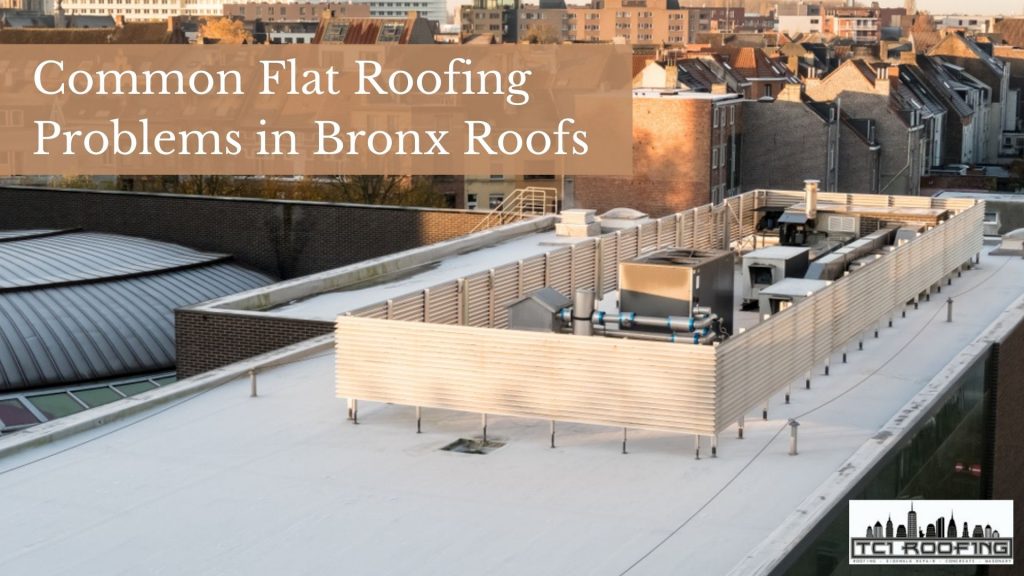A Flat roof is a roof with no steep slope, and it protects your home from weather such as rain or snow. Flat roofs can be made of metal, asphalt shingles, slate tiles, clay tile, or concrete. They are popular in places that experience extreme temperatures year-round because they provide insulation to protect against heat loss in winter and summer. However, there are some problems with flat roofs too! In this blog post, we will discuss the common flat roofing problems in Bronx roofs.
8 Common Flat Roofing Problems
One thing with flat roofs is the difficulty in pinpointing the specific source or cause of any flat roofing issue that may arise. When it comes to flat roofs, things aren’t always as they seem. Because water might linger between layers of roof materials for a long time before entering the house, the apparent location outside may be far from where the leak becomes noticeable inside.
Flat roofs are not without their drawbacks. If flat roofs are not properly maintained, the same properties that make them so useful can soon turn into vulnerabilities. Because you never know when you’ll have a roof problem, it’s a good idea to invest in roofing inspection and maintenance as soon as possible. As a homeowner or property manager in Bronx, NYC, you may encounter some of the following frequent flat roofing issues.
Let’s take a closer look at eight of the most common problems of flat roof to see how you can get the most out of it:
Openness
All flat roof difficulties stem from a lack of transparency. It is for this reason that it is ranked first on our list. Damage from the outside world is unavoidable because the roof of a building is continually exposed to the sun and other factors. No roofing material, regardless of how long-lasting, can last indefinitely.
Overexposure to the sun, lightning strikes, frost, hail, wind damage, and wind-driven debris are common flat roof problems. Other less common concerns include restaurant oil damage, pollution, and chemical exposure from the environment.
Ponding
By their very nature, flat roofs do not usually provide adequate drainage for water to go off. Although most flat roofs are built with a slope to allow for drainage, the lack of a natural slope can occasionally cause issues. Rainwater collects in standing ponds on the roof as a result. The weight of the ponding water will cause the roof to sag and even leak.
Watermarks
After a long ponding period, it will leave watermarks on your roof, allowing water to pass through on subsequent attempts. Watermarks may go unnoticed at first look, but they can be a severe issue. You’ll have an even bigger problem than ponding alone if your roof has been weakened and rainwater seeps through to the ceiling below from where it collects on flat roofs.
Vegetation
Any stagnant body of water, such as an unsupervised swimming pool with no water circulation, might support growth. Vegetation and algae can grow in ponding water on a flat roof that has been stagnant for a long time. A dirty roof will reflect less light, affecting the building’s interior and outdoor temperatures. It would be best to regularly clean roofs in danger of ponding water and check biological growth symptoms during a commercial roof inspection.
Breaking Or Extending At Joints Or Corners
The flexible materials that make up your roof’s watertight layers might crack or rip as they age due to drying out or extending. This is common with EPDM or elastic roofing (Ethylene-Propylene-Diene-Monomer).
Bleb
On flat roofs, bleb and other surface flaws such as “alligatoring” are pretty frequent. Alligatoring is the term used to describe a flat roof membrane that has deteriorated to the point that it resembles alligator skin. Over-exposure to the sun or saturated insulation are the most common causes of surface problems.
Rusted Or Missing Roof Nails
As bare nails corrode or fall out on older properties, they can turn your roof into a water passage point. Because flat roofs are made up of multiple layers, they are more prone to difficulties. From the outside, only a few nails may be visible, but there is usually an inner row as well. Water can push up those lower layers and penetrate the waterproofing layer on your roof.
Holes
Flat roofs frequently have holes. When this happens, they lose their ability to shed water, exceptionally if they are not maintained regularly. When dampness cannot absorb moisture from the roof, it will eventually find and enter the building.
Flat roof holes may appear harmless at first glance, but they can pose serious problems like roof leaks if not addressed and repaired promptly. Thus, roofs must have regular maintenance and address roof issues as soon as possible.
Preventative roofing maintenance is the best approach to avoid these roofing issues. Our Bronx roofing contractor recommend having your Bronx home’s roofing evaluated to detect minor roofing concerns and get them corrected before they become major problems.

